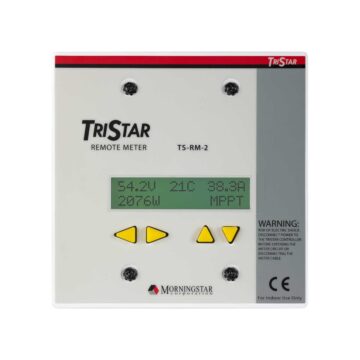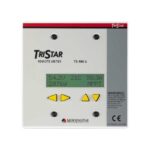TriStar Remote Meter-2
Remote Digital Display for the TriStar Family Controllers. The TS-RM-2 provides the same data display as the TS-M-2, except that it ships with 30 meters of cable and a flat faceplate. These features enable convenient mounting away from the controller. The meter enables manual functions and controller diagnostics. These capabilities will increase your confidence that the system is working properly and will help you to improve system reliability, battery life, and system performance.
Models: TS-RM-2,
Specifications and Certifications by Model
| Model | TS-RM-2 |
|---|---|
| Self Consumption | <0.5W, 42.5mA (backlight on) |
| Operating Temperature Range | -40 C to +60C |
| Warranty | 5 Years |
| CE and RoHS | Yes |
| ETL Recognized Component FCC Class B Part 15 Compliant | Yes |
| ACMA-EMC Compliant | Yes |
| Manufactured in a Certified ISO 9001 Facility | Yes |
Key Features and Benefits
Easy to install
- Uses standard 6 conductor RJ-11 connectors
- TS-RM-2 fits a “double gang” electrical box and includes 30 meters (98.4 feet) of cable
- Both data and meterbus power flow over a single cable
- Network supports up to 15 devices and, optionally, more than one meter per system
Networking capability
- Displays individual controller data from up to 15 TriStars with optional Morningstar MeterHub
- Aggregates system data to show total charge, load and battery charge/discharge state
- Auto detects any device found on the network
Easy to use
- Four directional push buttons for easy navigation of display screens
- Backlighting to enhance readability
- Meter may be added during initial controller installation, added as an upgrade anytime in the future or connected temporarily for troubleshooting with the ability to use this same meter at other sites



